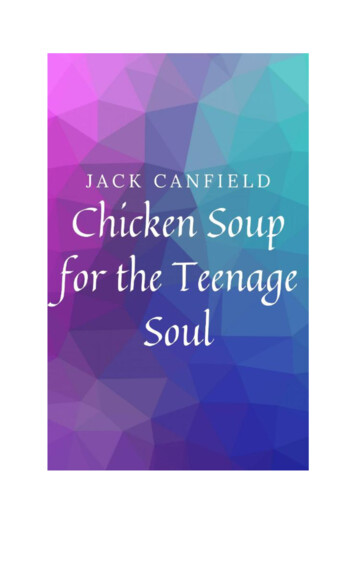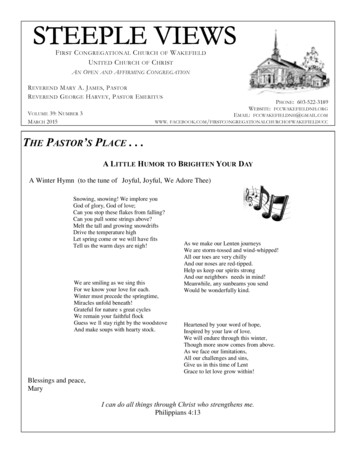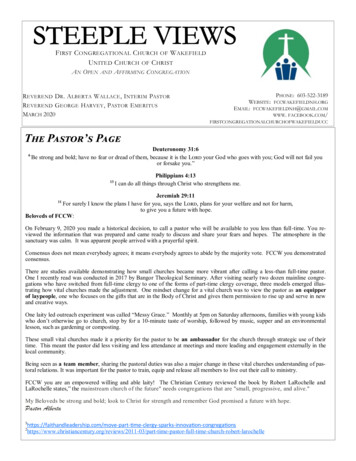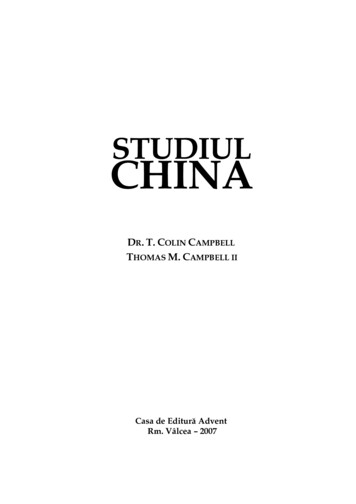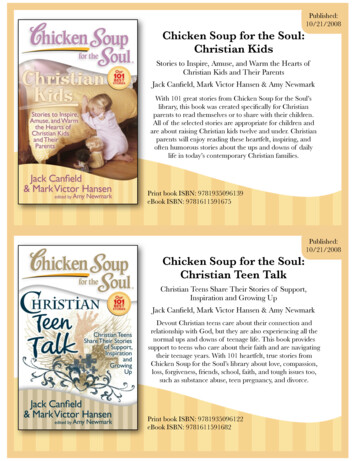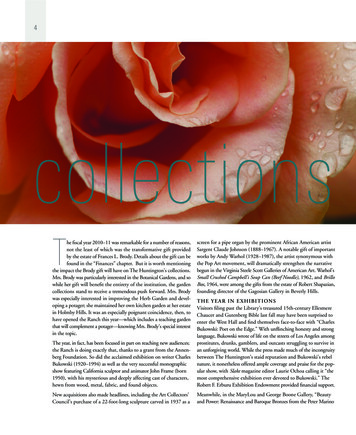
Transcription
4The fiscal year 2010–11 was remarkable for a number of reasons,not the least of which was the transformative gift providedby the estate of Frances L. Brody. Details about the gift can befound in the “Finances” chapter. But it is worth mentioningthe impact the Brody gift will have on The Huntington’s collections.Mrs. Brody was particularly interested in the Botanical Gardens, and sowhile her gift will benefit the entirety of the institution, the gardencollections stand to receive a tremendous push forward. Mrs. Brodywas especially interested in improving the Herb Garden and developing a potager; she maintained her own kitchen garden at her estatein Holmby Hills. It was an especially poignant coincidence, then, tohave opened the Ranch this year—which includes a teaching gardenthat will complement a potager—knowing Mrs. Brody’s special interestin the topic.screen for a pipe organ by the prominent African American artistSargent Claude Johnson (1888–1967). A notable gift of importantworks by Andy Warhol (1928–1987), the artist synonymous withthe Pop Art movement, will dramatically strengthen the narrativebegun in the Virginia Steele Scott Galleries of American Art. Warhol’sSmall Crushed Campbell’s Soup Can (Beef Noodle), 1962, and BrilloBox, 1964, were among the gifts from the estate of Robert Shapazian,founding director of the Gagosian Gallery in Beverly Hills.The year, in fact, has been focused in part on reaching new audiences;the Ranch is doing exactly that, thanks to a grant from the Annenberg Foundation. So did the acclaimed exhibition on writer CharlesBukowski (1920–1994) as well as the very successful monographicshow featuring California sculptor and animator John Frame (born1950), with his mysterious and deeply affecting cast of characters,hewn from wood, metal, fabric, and found objects.T HE YEAR I N EXHI BI T I ONSVisitors filing past the Library’s treasured 15th-century EllesmereChaucer and Gutenberg Bible last fall may have been surprised toenter the West Hall and find themselves face-to-face with “CharlesBukowski: Poet on the Edge.” With unflinching honesty and stronglanguage, Bukowski wrote of life on the streets of Los Angeles amongprostitutes, drunks, gamblers, and outcasts struggling to survive inan unforgiving world. While the press made much of the incongruitybetween The Huntington’s staid reputation and Bukowski’s rebelnature, it nonetheless offered ample coverage and praise for the popular show, with Slake magazine editor Laurie Ochoa calling it “themost comprehensive exhibition ever devoted to Bukowski.” TheRobert F. Erburu Exhibition Endowment provided financial support.New acquisitions also made headlines, including the Art Collectors’Council’s purchase of a 22-foot-long sculpture carved in 1937 as aMeanwhile, in the MaryLou and George Boone Gallery, “Beautyand Power: Renaissance and Baroque Bronzes from the Peter Marino
Collection” offered a chance to observe the heightened impact ofbringing works in private hands to The Huntington to show themin relation to similar objects in the collections. The exhibition included two dozen bronzes—many inspired by Greek and Romanmythology—from New York art collector and architect Peter Marino,enriched by several Renaissance bronzes from the institution’s ownholdings, most of which were purchased by Henry E. Huntingtonfrom the great collection of bronzes formed by J. Pierpont Morgan.After closing at The Huntington, the exhibition traveled to theMinneapolis Institute of Arts. The Ahmanson Foundation Exhibitionand Education Endowment provided support for the show, withadditional gifts from Laura and Carlton Seaver.The Huntington’s rose collections include more than 4,000 plants. This year marked the retirementof Clair Martin, the Ruth B. and E. L. Shannon Curator of the Rose and Perennial Gardens. Photo byMartha Benedict.O-Man, one of sculptures in the acclaimed exhibition “Three Fragments of a Lost Tale: Sculptureand Story by John Frame.” Photo by John Frame.“Taxing Visions: Financial Episodes in Late 19th-Century American Art” included Art Versus Law(1859–60), by David Gilmour Blythe (1815–1865), oil on canvas, Brooklyn Museum, Dick S. RamsayFund, 40.907.A complementary exhibition, “The Lure of Myth: British Drawingsfrom The Huntington’s Art Collections,” further explored the worldinhabited by gods and goddesses in the Works on Paper Room onthe second floor of the Huntington Art Gallery. The small showfeatured the work of 18th- and 19th-century British artists, includingJames Thornhill (1675–1734), Thomas Gainsborough (1727–1788),Henry Fuseli (1741–1825), and Thomas Rowlandson (1756–1827).“Three Fragments of a Lost Tale: Sculpture and Story by John Frame”featured a series of visually striking and mysterious vignettes bythe Southern California artist. The show, a dreamy sequence ofintricately carved figures set against elaborate and dramatically litsets, featured a cast of enigmatic characters, fully articulated, withmoving limbs, fingers, jaws, and eyes, evoking complex identitieswith distinct interests. The exhibition was accompanied by stillphotography and stop-motion animation; the Ahmanson FoundationExhibition and Education Endowment provided funding.On his radio show for KCRW, Edward Goldman reported, “Thisexhibition is a rare case where the artist was completely in chargeof the elaborate installation.” He went on to compare the preciselighting of the show with “the highlights brushed in by Old Mastersonto their dark canvases.”John Frame was also invited to curate a concurrent exhibition, “Bornto Endless Night: Paintings, Drawings, and Prints by William BlakeSelected by John Frame,” installed in the Huntington Art Gallery’sWorks on Paper Room. Frame cited the 18th-century English poet,painter, and printmaker as an early inspiration for his work.Focused, thematic shows offer the chance to exhibit rarely seen worksfrom the institution’s permanent collections. “Picturesque to Pastoral:British Landscape Prints from The Huntington’s Art Collections,”in the Works on Paper Room in the Huntington Art Gallery, lookedat the graphic side of landscape in British art. From the rustic landscape depicted by Thomas Gainsborough to the visionary dreamscapes of Graham Sutherland (1903–1980), the dozen prints surveyeda wide range of techniques as well as changing views of the landscape, illustrating how artists reworked this subject matter to expresstheir own sensibilities.The Susan and Stephen Chandler Wing of the Virginia Steele ScottGalleries hosted three exhibitions this fiscal year, beginning withTHE HUNTINGTON ANNUAL REPORT 20115
6COLLECTIONS AT THE HUNTINGTONCHRONOLOGY OF EXHIBITIONSChild’s Play? Children’s Book Illustration of 19th-Century Britain*April 3, 2010–July 26, 2010 Huntington Art Gallery, Works on Paper RoomA Clash of Empires: The Seven Years’ War and British America*April 24, 2010–July 26, 2010 Library, West HallCalifornia Landscapes: Gifts to The Huntington’s Art Collections*May 15, 2010–Sept. 6, 2010 Virginia Steele Scott Galleries, Susan andStephen Chandler WingThe Artistic Furniture of Charles Rohlfs*May 22, 2010–Sept. 6, 2010 MaryLou and George Boone GalleryPicturesque to Pastoral: British Landscape Prints from The Huntington’sArt CollectionsJuly 31, 2010–Nov. 1, 2010 Huntington Art Gallery, Works on Paper RoomEvolving Ideas: Midcentury Printmakers Explore ProcessOct. 2, 2010–Jan. 3, 2011 Scott Galleries, Chandler WingBeauty and Power: Renaissance and Baroque Bronzes from the PeterMarino CollectionOct. 9, 2010–Jan. 24, 2011 Boone GalleryCharles Bukowski: Poet on the EdgeOct. 9, 2010–Feb. 14, 2011 Library, West HallThe Lure of Myth: British Drawings from The Huntington’s Art CollectionsNov. 6, 2010–Mar. 7, 2011 Huntington Art Gallery, Works on Paper RoomTaxing Visions: Financial Episodes in Late 19th-Century American ArtJan. 29, 2011–May 30, 2011 Scott Galleries, Chandler WingThree Fragments of a Lost Tale: Sculpture and Story by John FrameMarch 12, 2011–June 27, 2011 Boone GalleryBorn to Endless Night: Paintings, Drawings, and Prints by William BlakeSelected by John FrameMarch 12, 2011–June 27, 2011 Huntington Art Gallery,Works on Paper RoomRevisiting the Regency: England, 1811–1820April 23, 2011–Aug. 1, 2011 Library, West HallPre-Raphaelites and Their Followers: British and American Drawings fromThe Huntington’s CollectionsJune 25, 2011–Sept. 26, 2011 Scott Galleries, Chandler Wing*Opened during fiscal year 2010 and covered in more detail in previousAnnual Report“Evolving Ideas: Midcentury Printmakers Explore Process.” Thedisplay of two dozen works highlighted technical innovations inprintmaking in the United States from the 1930s through the 1950s.The exhibition was made possible by recent acquisitions of midcentury American prints, including gifts from Hannah S. Kully.Sometimes events that occur during the planning of an exhibitioninstill it with greater meaning. One example was a show in theChandler Wing of the Scott Galleries that opened in January.“Taxing Visions: Financial Episodes in Late 19th-Century AmericanArt” explored treatments by artists of the theme of financial turmoilin the 19th century just as the effects of the current recession werebeing felt.The 34 works on loan from 31 museums and private collectionsincluded a diverse group of artists, including William MichaelHarnett (1848–1892), George Inness (1825–1894), EastmanJohnson (1824–1906), and James Abbott McNeill Whistler (1834–1903). Kevin Murphy, the Bradford and Christine Mishler AssociateCurator of American Art at The Huntington, co-curated the exhibition with Leo Mazow, curator of American art, Palmer Museum ofArt at Penn State University. The exhibition was made possible withfunds from the Steve Martin Fund for Exhibitions of American Art.In contrast, an exhibition that opened in the Chandler Wing ofthe Scott Galleries at the end of the fiscal year probed a commonoccurrence in the history of art: artists turning to an imaginativeworld of myth and fantasy for inspiration. “Pre-Raphaelites andTheir Followers: British and American Drawings” featured 37 drawings and watercolors from The Huntington’s collections, includingworks from British artists Dante Gabriel Rossetti (1828–1882) andWilliam Holman Hunt (1827–1910) as well as Americans WilliamMorris Hunt (1824–1879) and Henry Roderick Newman (1843–1917). The exhibition was co-curated by the associate curator ofBritish art, Melinda McCurdy; and the University of California atSanta Barbara-Huntington curatorial fellow, Matthew Fisk. TheChandler Exhibition Endowment provided funding for this and allChandler Wing exhibitions.A spring exhibition in the Library’s West Hall, curated by MaryRobertson, William A. Moffett Curator of English HistoricalManuscripts, explored a glittering yet turbulent era in British history,when England’s King George III was deemed unfit to rule; his son,the Prince Regent, assumed the reins. “Revisiting the Regency:England, 1811–1820” combined more than 70 rare books, manuscripts, prints, and drawings to commemorate the 200th anniversary of the Regency decade. Funding from the Robert F. ErburuExhibition Endowment made this exhibition possible.BOTANI C AL SHOW S AND EVENTSBotanical shows bring together expert horticulturalists and magnificent specimens while also enticing the general public who seek tolearn more about plants and flowers. Early summer saw the 46thAnnual Cactus and Succulent Show, presented by the Cactus andSucculent Society of America. The event showcased rare specimens
from around the world, including plants native to Mexico, Chile,Argentina, Botswana, Madagascar, and the Middle East. Perhapsthe largest activity of the summer was the American HorticulturalSociety (AHS) Youth Gardening Symposium, in which gardens andeducation staff hosted workshops and programs organized by AHS.was organized by Clair Martin, the Ruth B. and E. L. ShannonCurator of the Rose and Perennial Gardens, who retired at the endof the fiscal year after a remarkable 28-year career. Under Martin,The Huntington became a center for interpretation and conversationabout the history and development of cultivated roses.In September, the 27th Annual Succulent Plants Symposium featuredkeynote speaker John Lavranos, who discussed the people and placeshe encountered during 50 years of plant collecting in Africa. TheFall Plant Sale, held in early October, showcased not only a wondrousarray of plants but also expert advice on seasonal gardening topicssuch as mulching, pruning, winter lawn care, and pest control.Early February brought the annual Chinese New Year celebration.The popular program included performances by lion dancers anddrummers, martial arts demonstrations, shadow-puppet theater,children’s book readings, and mask-changing performances welcoming the Year of the Rabbit. The two-day celebration was sponsoredby East West Bank and featured artists from Chongqing, China,sponsored by ICN TV Network. Later that month, the 39th annualCamellia Show highlighted hundreds of gorgeous blooms competingfor top honors; The Huntington co-sponsored the show with theSouthern California Camellia Society. Visitors also enjoyed acresof blooming camellias in the North Vista, Japanese Garden canyon,and Chinese garden. The 8th Annual Clivia Show, presented bythe North American Clivia Society in March, featured dozens ofoutstanding entries plus plant sales and demonstrations.The Southland Orchid Show Committee presented its annual twoday event in mid-October in the Botanical Center and The RoseHills Foundation Conservatory for Botanical Science. The showincluded hundreds of exotic specimens in elaborate displays inaddition to vendors with a wide range of orchid plants and relatedmerchandise for sale.October also featured a reception for fine art photographer JonathanSinger, who created a portfolio of exotic flora entirely from TheHuntington’s collections. The resulting images, known as “TheHuntington 100,” were presented in December in the BotanicalCenter. “Jonathan elevates our appreciation of nature and remindsus of the wonderful diversity, beauty, and fragility of the world ofplants,” said James Folsom, the Marge and Sherm Telleen/Marionand Earle Jorgensen Director of the Botanical Gardens.In January, The Huntington hosted the Great Rosarians of the Worldwith rose preservationist Ruth Knopf as guest speaker. The occasionInternationally recognized bonsai masters shared their passion forthis ancient art form at the Bonsai-A-Thon, including exhibits,demonstrations, prize drawings, a “bonsai bazaar,” and live auctions.Bonsai lovers brushed up on their skills during workshops. The 54thAnnual Bonsai Show, an event separate from the Bonsai-A-Thon,also took place in March, with the California Bonsai Society displaying more than 100 beautiful specimens created by bonsai masters.The show featured Japanese black pine and California juniper,among other plant varieties.The 37th Annual Spring Plant Sale drew on the volunteer support of The Huntington’s Corporate Partners, including employees from the Walt Disney Co., Bank of America, Wells Fargo, City National Bank,and the Capital Group Companies. Botanical shows included spectacular displays, such as this specimen on view during the 54th Annual Bonsai Show.THE HUNTINGTON ANNUAL REPORT 20117
8COLLECTIONS AT THE HUNTINGTONIt was a strong year for the 37th Annual Spring Plant Sale, in May,with sales totaling 140,000, topping last year’s figures. Plant loversfound thousands of rare and unusual plants, including uncommonvarieties of roses, camellias, orchids, cacti, succulents, bromeliads,and palms. Highlights of the sale also included a wide variety ofvegetable seedlings along with herbs, fruits, and drought-tolerantplants, including California natives, reflecting an increasing interestin urban and sustainable gardening.The Second Thursday Garden Lectures featured talks covering tipsfor the home gardener as well as insightful historical presentations.Bart O’Brien explored how to incorporate California native plantsinto the landscape, Tom Spellman offered tips on growing highantioxidant fruits, and Andrea Wulf reached back in time to explainwhat plants and gardens meant to Presidents Washington, Adams,Jefferson, and Madison.AC QU I SITI O N HI GHLI GHTSArtEach year, the 45 families from the Art Collectors’ Council face awelcome challenge—providing direction for new acquisitions aimedat strengthening The Huntington’s current collections. Since 2010,the council has focused on one field each year—either American orEuropean objects—allowing the collections to take turns enjoyingthe full impact of its purchasing power.This year the council chose two works that curators presented forconsideration, including a 22-foot-long sculpture carved as a screenfor a pipe organ by the prominent African American artist SargentClaude Johnson (1888–1967) in 1937. Best known for his imageryof animals and people, particularly African and Native Americansrendered in Abstract Figurative and Early Modern styles, Johnsonwas one of the first African American artists in California to achievea national reputation. He worked as a painter, printmaker, andceramicist but is best known as a sculptor. Under the auspices ofNOTABLE ART ACQUISITIONSVincennes (French), Sugar Box, ca. 1748, soft-paste porcelain, gift ofMaryLou Boone.Jacob van Walscapelle (Dutch, 1644–1727), Still Life with Fruit (mid 17th–early 18th century), oil on canvas, gift of John and Mary Ann Sturgeon.Joseph Leonard Roque (French, active 1769–died after 1789), mantel clock(ca. 1780), marble and gilt bronze, gift of Suzanne Kyro and Niklas Hallberg.Sam Maloof (American, 1916–2009), rocking chair (1998), walnut andebony; and curved laced bench (ca. 1965), walnut and ebony; gift ofDaniel and Phillip Greenberg in memory of Ruth C. Greenberg.High chest of drawers (ca. 1690–1720); walnut, yellow pine, white pine withwalnut and bur ash veneer; gift of Victor Gail from the Gail-Oxford Collection.Set of 46 American prints, including Thomas Hart Benton (American,1889–1975), Jessie James (1935), lithograph; and Frankie and Johnnie(1936), lithograph; gift of Hannah S. and Russel I. Kully.Set of 73 works on paper, including Salvatore Pinto (American, 1905–1966), Ballerina Resting (ca. 1930), wood engraving, gift of Bonnie andLee Stone.Set of eight works by Roger Medearis (American, 1920–2001), includingWinter Fields (1950), oil on Upson board, gift of Elizabeth Medearis.the Federal Art Project, the visual arts division of the Depression-eraWorks Progress Administration (WPA), Johnson carved the monumental relief of musicians, animals, birds, and plants as a screenfor a pipe organ in the hall of the California School for the Blindin Berkeley, Calif. Made of redwood, adorned with paint and gilding, the sculpture was backed with plywood in order to preserve itfollowing its removal from the building after the school relocatedand the building became part of the University of California campus.It will join the growing collection of American art from the 1930sNew art acquisitions this year included (below) Sargent Claude Johnson (1888–1967), Untitled (screen for pipe organ), 1937, purchased by the Art Collectors’ Council; (upper right) David Wilkie (1785–1841), Sancho Panza in the Days of his Youth, 1835; and (lower right) Andy Warhol (1928–1987), Brillo Box, 1964, gift of the estate of Robert Shapazian.
early variant of the famous series of paintings,and his Brillo Box, constructed in 1964 atthe time of the artist’s first sculpture exhibition. The works came to The Huntingtonfrom the estate of Robert Shapazian.Rounding out the gift was a group of nineunlicensed copies of Brillo Box commissioned in 1990 by art collector and international museum director Pontus Hultén.In the fall, the acquisition of Sancho Panzain the Days of his Youth (1835), by Britishpainter David Wilkie, enhanced the European art collection. “Opportunities to buyanything by Wilkie, let alone a major finished picture, are extremely rare,” said JohnMurdoch, Hannah and Russel Kully Director of Art Collections. Previously, TheHuntington had only one small sketch andseveral drawings by Wilkie. This acquisitionwas made possible through funds in theBrowning Memorial Art Fund.LibraryEach year, a group of major donors, theLibrary Collectors’ Council, directs thegrowth of the collections by choosing purchases that will best strengthen existingholdings. This year’s council settled on fiveitems, including Claudio Bérigard’s Doubtson the “Dialogue” of Galileo (Dubitationes indialogum Galilaei Galilaei) (1632), whichfurther solidified The Huntington’s positionas a preeminent center for the study of thehistory of science. The work challengesGalileo’s famous and controversial contention that the earth revolved around the sun.and was the first major work by an African American artist to enterThe Huntington’s art collections. The council purchased the workin honor of Robert C. Ritchie and George Abdo on the occasionof their forthcoming retirements.The other purchase, Harlem Flats (Back Lot Laundry), is an important early painting made in 1907 by Ernest Lawson (1873–1939),one of a group of Ashcan school artists called The Eight. HuntingtonOverseer Kelvin Davis purchased Harlem Flats, offering to acquireit outright before the group began voting on new acquisitions,thereby allowing the council to seize the opportunity to purchasethe organ screen.The American collection also received a major boost to its artholdings through gifts, most notably Pop Art legend Andy Warhol’sSmall Crushed Campbell’s Soup Can (Beef Noodle), 1962, a unique,“The Huntington’s holdings on Galileo areamong the most extensive in America,” saidDavid Zeidberg, Avery Director of theLibrary. “Bérigard’s church-backed responsegives important context to the times andculture in which Galileo lived.”ART COLLECTORS’ COUNCILSushma and Ashwin AdarkarAnn and Olin BarrettNancy Berman and Alan BlochDiane and Fred BlumMaryLou BooneMaribeth and William H. BorthwickCaron and Steve BroidySusan and Stephen ChandlerFaye and Robert DavidsonKelvin DavisLinda DickasonKaren and Eric EndeLois and Bob ErburuJudith and Stanley FarrarConnie and Gordon FishBeverly FitzgeraldMarcia and George GoodMaria and Richard GrantHeather and Paul HaagaKelsey HallClaudia Huntington and Marshall MillerSally and William HurtPatricia JohnsonMargery and Maurice KatzHannah and Russ KullyClaude and Frank LoganDiane and Trevor MorrisCharles T. MungerHarlyne NorrisCarol and Laurence PrettyMarge RichardsAnne and Jim RothenbergLaura and Carlton SeaverRuth B. ShannonStewart Smith and Robin FerraconeBarbara SteeleMary Ann and John SturgeonPhillip SwanBetsy and Joseph TerrazasGeneva and Chuck ThorntonJoan and Dave TraitelSally WenzlauAlyce and Warren WilliamsonDeborah and Robert WycoffBillie YeagerTwo other purchases brought greater depthto the Library’s holdings in several key areasof 19th-century Americana. A maritimediary written in 1842 describes the experience of surgeon GeorgeClymer aboard the USS Cyane, a sloop-of-war vessel touring thePacific Ocean. The diary reflects the continuing expansion of theUnited States’ political and economic interests across the globe. Andthe manuscript collection of Charlton Thomas Lewis (1834–1904),a true American polymath—Methodist preacher, mathematician,THE HUNTINGTON ANNUAL REPORT 20119
10LIBRARY COLLECTORS’ COUNCILMerle and June BantaDiane and Fred BlumMaryLou BooneRichard and Nancy CallBruce and Marty CoffeyJoe and Alice CoulombeLois and Bob ErburuJudith and Stanley FarrarJohn and Alisa FickewirthGordon and Connie FishMaria and Richard GrantClaudia Huntington and Marshall MillerScott Jordon and Gina ValdezClaude and Frank LoganFrank and Mona MapelKen and Tracy McCormickDiane and Trevor MorrisCharles T. MungerBetty NickersonCharles and Eileen ReadMarge RichardsErika and Ken RileyJoel and Ricki RobinsonJanet and Stephen RogersLoren and Frances RothschildLaura and Carlton SeaverRuth B. ShannonStewart Smith and Robin FerraconeDick and Nancy SpelkeAlan and Janet StanfordPhillip SwanGeneva and Chuck ThorntonRobert and Anna Marie WarrenDeborah and Robert Wycoffclassical scholar, lawyer, journalist, writer, and social reformer—covers a period from the early 19th century through 1915, touching on a variety of subjects, from the religious revivals of theantebellum era to prison reform. It consists of approximately 1,260items as well as 200 pieces of ephemera.The other two purchases by the council are highly visual works, areminder that Library acquisitions are not restricted to the writtenword. A manuscript proposal by Lewis Kennedy (1789–1877) forthe development of landscape gardens in Cornwall, England, offersinsights into English garden history. The 12 pages of hand-writtentext are complemented by eight original watercolor paintings and fivepen-and-wash vignettes, bound in a green morocco-gilt presentationalbum. A set of 15 gouache designs by Susan Hertel (1930–1993)supplied artistic direction for one of Southern California’s mostsignificant public art projects—a series of vibrant and compellingmosaic murals installed at more than 100 Home Savings and Loanbuildings under the direction of Millard Sheets (1907–1989), aprominent Claremont mosaic artist and educator. Hertel was theprimary designer of mosaics and worked closely with Denis O’Connor(1933–2007), an English artist and graduate of the Royal Collegeof Art in London who joined Sheets’ company in 1960 and whosepapers are already at The Huntington.Other acquisitions during the year enhanced The Huntington’sexisting collections. Jay Last donated 36,000 items from his collection of graphic arts and social history, representing a significantportion of a continuing gift in progress that is in excess of 140,000prints, posters, and ephemera.The adage that the whole is more than the sum of its parts rang truefor another acquisition, the purchase of six pages of diary entriesrecounting events leading up to, and immediately following, theBattle of Lexington Green in 1775. The hand-written manuscriptby noted Boston preacher and patriot Samuel Cooper (1725–1783)gave a rare eyewitness account of the battle that marked the startof the American Revolutionary War.Top: Lewis Kennedy (1789–1877), “View from the flower-gardensof the park and distant scenery,” watercolor from a manuscriptproposal for the development of landscape gardens at TrebarthaHall, in Cornwall, England, 1815. Center: Claudio Bérigard, Doubtson the “Dialogue” of Galileo (Dubitationes in dialogum GalilaeiGalilaei), Florence, Petri Nesti, 1632. Bottom: Newly acquiredpages from the diary of Samuel Cooper (1725–1783) match upperfectly with a portion of the diary in the Library’s holdings.
Of great historic importance in their own right, the pages took onadditional meaning when conservators held them next to pages froma colonial diary already in The Huntington’s holdings.“It was a perfect fit—written in the same hand and on the same paper,”recalled Olga Tsapina, the Norris Foundation Curator of AmericanHistorical Manuscripts. “When put together, these two look likepieces of a jigsaw puzzle. This kind of thing hardly ever happens.”Other significant acquisitions of the year include: A collection of 1,200 items of late 19th-/early 20th-centuryephemera relating to California, Nevada, Arizona, and Hawaii;gift of Neal and Mary Jane Brockmeyer. Greenville Collins, Cartes et plans de plusieurs parties des côtesd’Angleterre, d’Écosse et d’Irlande (Paris?: Ministère de la Marine?,1757), gift of Dr. Cindy and John Carson. Photos, prints, and ephemera from the Eric DeLony Engineeringand Bridge Collection, ca. 1750–2000, gift of Eric DeLony. A collection of photos and ephemera relating to Southern California,including the San Gabriel Mission and the Mission Play recountingCalifornia’s founding (ca. 1862–1955), gift of Connie Rothenstein. Eight early printed books and three manuscripts dating fromthe 16th to 18th centuries from the Edward Lasker EquineCollection, gift of the Cynthia Lasker Estate through her son,Courtland Palmer. A typescript of the Kingsley Amis novel We Are All Guilty,made possible through the Estelle and Clarence H. AlbaughAcquisition Fund. The papers of English novelist Elizabeth Jane Howard (1933–2009), made possible through the Estelle and Clarence H.Albaugh Acquisition Fund.for the extensive display of penjing planned for the next phase of theChinese garden. (The horticultural art of penjing is similar to Japanesebonsai.) Cecilia Mong-Vajna’s gift, a stone chess table and stools,was also installed in the Chinese garden just before the celebration.Other donations amplified and built on The Huntington’s existingcollections. The Zillgitt Bonsai Court, dedicated last year, benefittedfrom numerous gifts this year, including 34 bonsai styled by the lateSheldon Gollin along with 12 bonsai pots, donated by his wife,Barbara; 10 bonsai styled by the late Minoru Maeda along withfive junipers, a gift of his wife Eiko and family; two crabapplebonsai from Ray and Marge Blasingame; and one oak and onegingko bonsai from the late actress Gloria Stuart.The Huntington’s expanding collection of orchids, which wasaugmented last year by more than 5,000 plants from the estateof S. Robert Weltz, continued to attract donations. This past year,Huntington Trustee Geneva Thornton gave six stunning ghostorchids along with two nutmeg trees. The ghost orchid, an extremelyrare plant found in Cuba and some parts of southern Florida, playeda central role in bestselling author Susan Orlean’s book The OrchidThief and the subsequent movie, Adaptation. Three slipper orchids(Paphiopedilum sanderianum) also entered the collection this yearfrom Fritz Schomburg, and one Bletilla orchid, from John Yates.Tamma Nugent donated a bronze hanging light and Japanese stonelantern, the latter of which has found a permanent position in thenew Japanese tea garden. Be
the Prince Regent, assumed the reins. "Revisiting the Regency: England, 1811-1820" combined more than 70 rare books, manu - scripts, prints, and drawings to commemorate the 200th anniver - sary of the Regency decade. Funding from the Robert F. Erburu Exhibition Endowment made this exhibition possible. BOTANICAL SHOWS AND EVENTS

